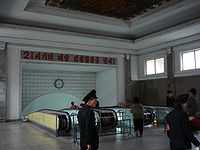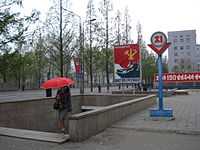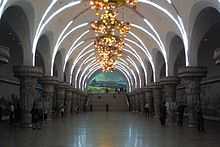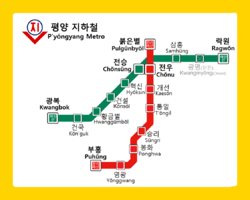Pyongyang Metro
| Pyongyang Metro | |||
|---|---|---|---|
 | |||
| Background | |||
| Owner | Pyongyang Municipal Government | ||
| Locale | Pyongyang, North Korea | ||
| Transit type | Rapid transit | ||
| Number of lines | 2 | ||
| Number of stations | 16+1 closed | ||
| Daily ridership | 300,000 - 700,000 | ||
| Operation | |||
| Began operation | 1969 | ||
| Operator(s) | Transport and Communication Commission[1] | ||
| Technical | |||
| System length | 22.5 km (14 mi) | ||
| Track gauge | 1,435 mm (4 ft 8 1⁄2 in) | ||
| |||
| Pyongyang Metro | |
| Chosŏn'gŭl | 평양 지하철 |
|---|---|
| Hancha | 平壤 地下鐵 |
| Revised Romanization |
Pyeongyang Jihacheo l |
| McCune–Reischauer | P'yŏngyang Chihach'ŏl |





The Pyongyang Metro (Korean: 평양 지하철 P'yŏngyang Chihach'ŏl) is the metro system in the North Korean capital Pyongyang. It consists of two lines: the Chŏllima line (Korean: 천리마선), which runs north from Puhŭng (Korean: 부흥) station on the banks of the Taedong to Pulgŭnbyŏl (Korean: 붉은별) station, and the Hyŏksin line (Korean: 혁신선), which runs from Kwangbok (Korean: 광복) station in the southwest to Ragwŏn (Korean: 락원) station in the northeast. The two lines intersect at Chŏnu (Korean: 전우) station. Daily ridership is estimated to be between 300,000 and 700,000.[2][3]
Construction
Construction of the metro network started in 1965, and stations opening between 1969 and 1972 by former President Kim Il-sung.[4][5] In 1971, there was a major accident during the construction of a tunnel under the Taedong River for the Ponghwa (Korean: 봉화) station. Some sources say at least 100 workers died in the accident.[6] This particular piece of tunnel was never completed; the metro network is now completely located on the western side of the river.
Pyongyang Metro is one of the deepest metros in the world—the track is claimed to be approximately 110 meters (about 360 feet) deep underground.[7] (The Saint Petersburg Metro also claims to be the deepest, based on the average depth of all its stations. The Arsenalna station on Kiev Metro's Sviatoshynsko-Brovarska Line is currently the deepest station in the world at 105.5 metres.[8] The Porta Alpina subway station is supposed to be 800 meters underground when it opens in 2017.[9]) The Pyongyang Metro has a museum devoted to its construction and history.
Network
The Pyongyang Metro network consists of two lines:
- Ch'ŏllima line, named after a very fast horse from ancient Korean mythology. It spans about 12 km (~8 mi). Construction started in 1968, and the line was opened on September 6, 1973.
- Hyŏksin line, which literally means renewal, spans about 10 km (~6 mi). Regular service started on October 9, 1975.
For the most part, the stations' names do not refer to the locations of the stations; instead, stations are named after themes and characteristics from North Korea's revolution. But Kaesŏn ("Triumph") is located at the Arch of Triumph.
The network is completely underground. The design of the network was based on metro networks in other communist countries, in particular the Moscow Metro.[10] Both networks share many characteristics, such as the great depth of the lines (100 meters plus) and the large distance between stations. Another common feature is the Socialist realist art that can be found in the stations such as murals and statues.[11] Staff of the Metro have a military-style uniform that is specific to these workers.
In times of war, the metro stations can serve as bomb shelters.[12] For this purpose, the stations are fitted with large steel doors.[13] Some sources claim that large military installations are connected to the stations,[14] and also that there exist secret lines solely for government use.[2][15]
One station—Kwangmyŏng (Korean: 광명)—is reported to be closed since 1995, due to the mausoleum of Kim Il-Sung located at that station. Trains do not stop at that station.
The Hyŏksin line is reported to have two new stations planned or under development, Yŏngung (Korean: 영웅) and Ch'ilgok (Korean: 칠곡). The map of the Hyŏksin line shows these two additional stations after Kwangbok station.
The map of the Chŏllima line shows two additional stations, Ryŏnmot (Korean: 련못), Sŏp'o (Korean: 서포), Ch'ŏngch'un (Korean: 청춘) and Mangyŏngdae (Korean: 만경대), at each end of this line which are planned or under development.
Each Metro station has a free toilet for use by patrons. Stations also broadcast the programs from state radio and have a display of the newspaper Rodong Sinmun.
One surprising detail is that many windows of the subway cars show signs of German graffiti. This is because the cars were mostly imported from Berlin, Germany. Meanwhile some North Korea tour operators have started offering chartered journeys on the old German trains through the entire metro system.[16]
Chŏllima Line
| Stations of the Pyongyang Metro | |||
|---|---|---|---|
| #1 Chŏllima 천리마선 Line | |||
| Station | Literal meaning | Transfer | Opened |
| Pulgŭnbyŏl 붉은별 | Red Star | 6 September 1973 | |
| Chŏnu 전우 | Comrade | #2 Chŏnsŭng | |
| Kaesŏn 개선 | Triumph | ||
| T'ŏngil 통일 | Reunification | ||
| Sŭngri 승리 | Victory | ||
| Ponghwa 봉화 | Torch/Beacon | ||
| Yŏnggwang 영광 | Glory | 10 April 1987 | |
| Puhŭng 부흥 | Revitalization | ||
Hyŏksin Line
| Stations of the Pyongyang Metro | |||
|---|---|---|---|
| #2 Hyŏksin 혁신선 Line | |||
| Station | Literal meaning | Transfer | Opened |
| Kwangbok 광복 | Restoration/Independence | 9 September 1978 | |
| Kŏn'guk 건국 | National Foundation | ||
| Hwanggŭmbŏl 황금벌 | Golden Soil | 6 September 1978 | |
| Kŏnsŏl 건설 | Construction | ||
| Hyŏksin 혁신 | Innovation | 9 September 1975 | |
| Chŏnsŭng 전승 | Complete Victory (in Battle) | #1 Chŏnu | |
| Samhŭng 삼흥 | Three Rejuvenations | ||
| Kwangmyŏng 광명 | Shine/Enlightenment | Closed in 1995 | |
| Ragwŏn 락원 | Paradise | ||
Operation

The Pyongyang Metro was designed to operate every few minutes. During the rush hours, the trains can operate at a minimum interval of 2 minutes. Until recently, many foreign tourists were only allowed to travel between Puhŭng Station and Yŏngwang Station. However, foreign students have been allowed to freely use the entire metro system. These two stations in this line that were completed in 1987, while the others in this line were all completed in 1973, suggesting that they may be less modern. It has also been suggested that foreign tourists are limited to the Puhŭng and Yŏngwang stations because these two stations are typically less crowded due to their location at the end of a line, therefore reducing interactions between foreigners and locals.[17] It is noted by more recent tourists, traveling with Koryo Tours and subsequently with other agencies that follow their plans as well that they can now ride the metro for 6 stations, this has been the case since 2010.[18] University students traveling with the Pyongyang Project have also reported visiting six stations.
It is also one of the cheapest in the world to ride, at only 5 KP₩ (about $0.03 USD) per ticket.[19] The Metro used to utilize an aluminium token, with the emblem of the Metro minted on it and the Korean "지". However, it now uses a paper ticket system also with 지 printed on it. Smoking and eating inside the subway system is prohibited, and punishable by a large fine.
Rolling stock
When operation of the metro started in the 1970s, newly built rolling stock was used. Although North Korea insists it was built in Korea, the four-car formations, known as DK4, were built in China by Changchun Car Company in 1972. All together 345 vehicles were built, of the whole, only 112 cars were actually used. In 1998, some of these trainsets were sold to the Beijing Subway, where they served in three car formations on line 13 (they have since been replaced by newer DKZ5 and DKZ6 trainsets; it is unknown if the DK4 units have been returned to Pyongyang).

Since 1998, the Pyongyang metro has used former German rolling stock from the Berlin U-Bahn. There are two different types of rolling stock:
- GI ("Gisela"), former East Berlin stock, built between 1978 and 1982.
- D ("Dora"), former West Berlin stock, built between 1957 and 1965.
The trainsets received a new red and cream livery in Pyŏngyang. All advertising was removed and replaced by portraits of the deceased leaders, Kim Il-sung and Kim Jong-il.
Recent travelers have only seen type D and, rarely, DK4 in operation; the GI-type has been replaced by the Dora-stock. GI-trains are used at the railway network around Pyongyang.[20]
Foreign tourists visiting North Korea can only see the metro as part of guided tours of Pyongyang. However, a BBC reporter who was covering the visit of U.S. Secretary of State Madeleine Albright in 2000 was able to walk around the city without being accompanied, and saw "old East German trains complete with their original German graffiti."[21] Recent photographs taken by visitors all show the same handful of type D trains, so it is possible that only a few type D trains have been repainted and that these are the only ones shown to foreigners on guided tours.[22] A visitor in 2004 noted 40 cars at one line, divided in ten trains[citation needed]. Recent travelers have also seen DK4 on excursion operation, mostly in 2006 and 2007 in 4-car formation. As for 2006 fotos, Hyŏksin line is served only by DK4 trainsets. As for 2014, it is now possible for tourists to take chartered rides on type D trains through the entire metro system, including visits to all stations. [23]
|
|
Sŏp'o | |||
|
|
Ryŏnmot | |||
|
|
Pulgŭnbyŏl | |||
|
|
Chŏnu( Chŏnsŭng) | |||
|
|
Kaesŏn | |||
|
|
T'ongil | |||
|
|
Sŭngni | |||
|
|
Ponghwa | |||
|
|
Yŏnggwang | |||
|
|
Puhŭng | |||
|
|
Ch'ŏngch'un | |||
|
|
Mangyongdae | |||
|
|
Ragwŏn | |||
|
|
Kwangmyŏng | |||
|
|
Samhŭng | |||
|
|
Chŏnsŭng( Chŏnu) | |||
|
|
Hyŏksin | |||
|
|
Kŏnsŏl | |||
|
|
Hwanggŭmbŏl | |||
|
|
Kŏn'guk | |||
|
|
Kwangbok | |||
|
|
Yŏngung | |||
|
|
Ch'ilgok | |||
Museum
Pyongyang Metro has its own museum. A large portion of the collection is related to President Kim Il-sung's providing "on the spot guidance" to the workers constructing the system. Among the exhibits are a special funicular-like vehicle which the president used to descend to a station under construction (it was riding in the inclined tunnel that was to be eventually used by the escalators), and a railbus in which he rode around the system.[24]
See also
- Transportation in North Korea
- Pyongyang Tram
- List of Korea-related topics
- List of rapid transit systems
- Seoul Metropolitan Subway
References
- ↑ The Pyongyang Metro: Statistics
- ↑ 2.0 2.1 Harris, Mark Edward; Cumings, Bruce (2007). Inside North Korea. Chronicle Books. p. 41. ISBN 978-0-8118-5751-2.
- ↑ "CNN Special Investigations Unit: Notes from North Korea". CNN. May 11, 2008.
- ↑ http://www.pyongyang-metro.com/metronews.html
- ↑ Infos at cafe306.daum.net
- ↑ "Станция "ПОНГВА" - "Путеводный Огонь"".
- ↑ "平壤的表情:你不知道的朝鲜" (in Chinese). Netease. July 31, 2007.
- ↑ Официальный сайт киевского метрополитена. Kiev Metro.
- ↑ http://news.discovery.com/tech/worlds-largest-tunnel-drilled-under-swiss-alps.htm
- ↑ Korea: North-South nuclear issues : hearing before the Subcommittee on Asian and Pacific Affairs of the Committee on Foreign Relations, House of Representatives, One Hundred First Congress, second session, July 25, 1990. U.S. G.P.O. 1991. p. 85.
- ↑ Ishikawa, Shō (1988). The country aglow with Juche: North Korea as seen by a journalist. Foreign languages Pub. House. p. 65.
- ↑ Robinson, Martin; Bartlett, Ray; Whyte Rob (2007). Korea. Lonely Planet. p. 364. ISBN 978-1-74104-558-1.
- ↑ Springer, Chris (2003). Pyongyang: the hidden history of the North Korean capital. Entente Bt. p. 125. ISBN 978-963-00-8104-7.
- ↑ Min, Park Hyun (August 20, 2007). "Pyongyang Subway Submerged in Water". Daily NK.
- ↑ "Kim Jong-il 'Has Secret Underground Escape Route'". The Chosun Ilbo. March 1, 2011.
- ↑ Pyongyang-Travel.com
- ↑ Burdick, Eddie (2010). Three Days in the Hermit Kingdom: An American Visits North Korea. McFarland. p. 57. ISBN 978-0-7864-4898-2.
- ↑ North Korea with Koryo photos,
- ↑ Hooi, Ng Si (September 6, 2008). "A world of its own". The Star (Malaysia).
- ↑ http://www.farrail.de/seiten/tour-report/nordkorea-dampf+m62-2007-04.html
- ↑ Lister, Richard (October 8, 2000). "Life in Pyongyang". BBC News.
- ↑ "Metro News". pyongyangmetro.com. 2006.
- ↑ http://www.pyongyang-travel.com/files/EN_public_transport_tour_TRAIN.pdf
- ↑ The forbidden railway: Vienna - Pyongyang 윈 - 모스크바 - 두만강 - 평양. Tuesday, September 23, 2008. The Demilitarized Zone
Literature
- Pyongyang Metro, Pyongyang: Foreign Languages Publishing House, 1980
- Пхеньянский метрополитен. Путеводитель. — КНДР: Издательство «Корея», 1988.
External links
| Wikimedia Commons has media related to Pyongyang Metro. |
- Video showing the Metro in North Korea
- Comprehensive site about the Pyongyang Metro
- Pyongyang at Urbanrail.net
- Pyongyang Metro photos from 2008
- Photos and information (Russian)
- Photos and information (Russian)
- Photos and information (Russian)
- Video showing the Pyongyang Metro Museum
- Video showing the Pyongyang Metro Museum
- Video showing ticket collection
- Video of the Exit to the "Glory" station
- Video showing Newspaper Use in the Metro
- Network map
- "Kim Jong-il 'Has Secret Underground Escape Route'" Chosun Ilbo
- Inspection At The Metro Station Entrance - No Shabby Cloths, No Large Luggage! Rimjin-Gang
- Photo of line cueing to purchase metro tickets
- video of passengers exiting a metro train.
